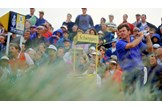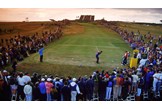Nick Faldo on his second Muirfield Open win in 1992
Published: Last updated:
It’s 26 years now since Sir Nick Faldo walked up the 18th hole on a grey, overcast Sunday afternoon at Muirfield to collect his first Major title – you can read about his 1987 memories here – fast forward five years and the Englishman was doubling up at Muirfield.
Muirfield 1992
In 1992, you were the hot favourite.
There was expectation, but I felt I could handle it because I was swinging the club well. It was a time when I used to think that I could hit a two-yard fade or a two-yard draw to order. My confidence was high. I also went into that championship having prepared meticulously. Fanny and I worked hard on our analysis of the course, mapping out in fine detail all the humps and bumps that fronted the greens. We made drawings and notes from 50 yards and in so that if I wanted to run the ball, I’d know exactly where it needed to land. Whether it was up or down and whether it would kick left or right.
I presume you had a metal driver?
You’d think so, but no. This was another MacGregor M85. I used metal to win the Masters in 1990, but I went back to the wooden head for the Muirfield Open.
Back to persimmon? I’m amazed.
It’s all about feel and strategy, sunshine. I remember when real golfers used to play with wood. A 1-iron, metal spikes, Balata ball and cashmere – those were the days!
I had an extra wedge in the bag by now, too. After 1990, I put in a lob wedge and then had a 53˚ club before my pitching wedge. Then it was Mizuno irons down to the 2-iron. They made me my own grindings. There was a lad called ‘Turbo’ who was incredible at shaping the heads by hand. I had four sets that all looked identical. I also had a beryllium Ping B60 putter with five degrees of loft.
Is loft that important on the putter?
On our fescue greens, you had to pop it and brush it. Look at how Seve used to putt. You can’t use your super-smooth Augusta stroke because the thing would only get halfway to the hole. With the wind and rain, you need to be more aggressive. I used to work at hitting the ground with the sole of the club on the practice green. You can’t do that on the course, but in practice I tried to instil a little bit of wrist movement in the stroke to get the ball running at the hole better. Some softness in the transition.
After two rounds, you were 12 under and three shots clear, breaking Henry Cotton’s 36-hole record.
I was just doing everything right. I took five at 17, so I could have been even better, damn it! When you’re expected to win, it’s different, though. I was four ahead on the 1st tee on Sunday, but things didn’t go well, initially. I started making mistakes. Hit a couple of bad shots, bad alignment, three-putted 13 and then hit it into a bunker on 14. I kept telling Fanny I was alright. It wasn’t like I was choking, I felt good. I was just making a mess of it.
On 11, you shoved a wedge into a bunker.
I watched that later on television and I was amazed to see that my whole body was aligned to the right. How could I have got my posture so wrong there? It just shows how easy it is to mess up. You’re out there blaming your swing when the actual stroke itself was fine. That’s what I teach kids – be factual about your analysis.
What happened to turn things around?
I walked off the 14th green and looked at the leaderboard to see I was two back from John Cook. I told myself that I needed to play the best four holes of my life. The walk to the 15th was pivotal. It was the determination. I just said, ‘Right, we forget everything. The last 68 holes don’t matter’.
Then the wonderful iron approach on 15.
Yes, that was good. It’s a shot we’d been working on all week, a little soft, chicken wing, soft arm thing. It was an awkward wind, just enough that if you necked it at all you’d miss miles right. And you had to get it right up the middle of the green. It had to land left of the flag even on a left-to-right breeze and then feed down.
How far was it?
Not very far, about 167. A knock down 5-iron. I’m trying to think now what happened next.
You chipped it close on the short 16th.
That’s right, I went long and hit a great chip to two feet. Then came the driver and 4-iron on 17. That drive must still rate as one of my best ever – a four-yard draw off a little red postbox I was aiming at in the tented village. I knew I couldn’t block the iron shot right because I’d never get up and down, so I nailed it 20 feet left. I was dying to hole the putt for a cushion, but left it short.
If you have to make a par, the 18th at Muirfield isn’t the easiest.
Every single step I said to myself, ‘Four to win, four to win’. I must have said it 80 times on the walk back to that 18th tee. It was a 3-wood leaving a 3-iron in.
There’s a photograph of the ball leaving the clubface on that approach shot. Good old Phil Sheldon took that. Sadly, he’s no longer with us, but I’ve got that as one of the best seven pictures of my life.
Should he have taken that photo seeing as you were at impact?
Oh, he was good, so I’ll let him off! I’m pleased he did because that was probably the best shot of my career. The ball ran on and finished high in the first cut. I caught it rather high on the blade of the wedge with my chip. Good job there was a big slope down to the pin because it came out softer than I’d planned.
And then your shoulders slumped when you holed the final putt.
There was a lot of pressure and the fear factor was there. I almost blew it and the scar from that might have been a hard one from which to recover. I could feel the adrenaline drop out of me. It went right down to my boots.
Faldo on that ‘Heart of the bottom’ moment
Sir Nick’s speech, after the ’92 Open, attracted almost as many column inches as the final round itself. It wasn’t so much his rendition of ‘My Way’ in which he instigated the slightly feeble help of the crowd, but his back-handed slap at the golfing media. When he said that he would like to “thank the press from the heart of my bottom,” he created a moment that, for some, would be the lasting memory of the Championship that year. But Faldo is adamant, even now, that what he said was well grounded.
“How harmful is that in this day and age? I mean, come on? I was seriously pissed off,” he explains. “They’d intentionally beaten on me. I’d won two Majors in 1990 and then had a lousy year in ’91. They sent their boys out to the Irish Open to write that Faldo’s finished, but I went and won it. Then they gave me a hard time at the Ryder Cup, which doesn’t help when you’re not playing well.
“Peter Alliss was criticising how I practised, when he’d never watched me practise. Everyone was chipping in with what seemed like a negative opinion. So you have all that and then you go out and win The Open for a third time. It was a polite way of saying, ‘Well, up you lot!’
“I don’t regret it. I didn’t use colourful language. It was a harmless, tongue in cheek remark. When you consider the malicious stuff that’s been written about me over the years – much of it fabricated – I think my response was very low key. “People don’t appreciate that for 10 or 15 minutes after the final putt, you’re not thinking clearly. You’re lost in the emotion. The only way to describe it is to say that it’s like avoiding a car crash. Your body is shaking and your stomach is upside-down. You’re in a bit of shock. So, hey, it was fine. If any individual member of the media was offended, then good. They just don’t know when I’m being serious. Ninety nine per cent of the time it’s tongue in cheek.”



